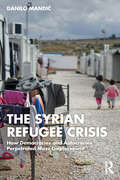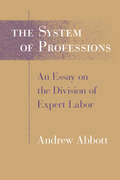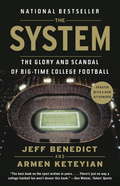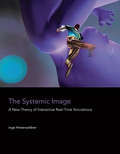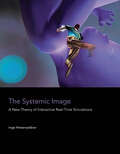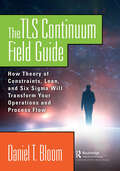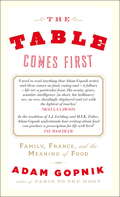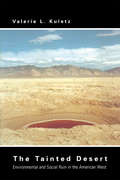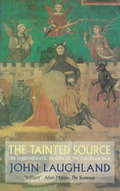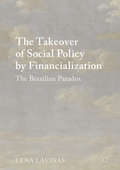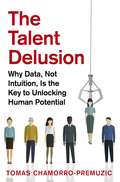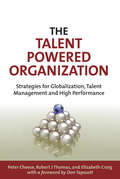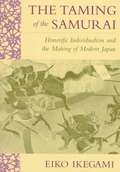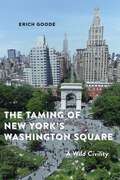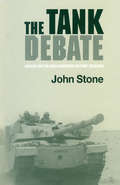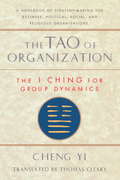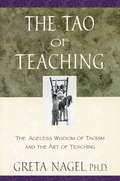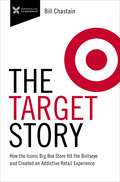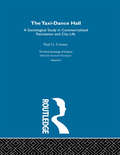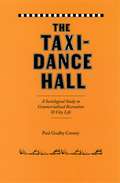- Table View
- List View
The Synchronization of National Policies: Ethnography of the Global Tribe of Moderns (Routledge Advances in Sociology)
by Pertti AlasuutariThe Synchronization of National Policies shows how it is possible that there is remarkable uniformity in the policies that the nation-states adopt, although there is no world government. Mainstream research attributes such global governance to the influence of leading countries, to functional requirements created by capitalism and technological development, or to international organizations. This book argues that to understand how national policies are synchronized we need to realize that the global population forms a single global tribe of moderns, divided into some 200 clans called nations. While previous research on the world culture of moderns has focused on the diffusion of ideas, this book concentrates on the active role of local actors, who introduce global models and domesticate them to nation-states. In national policymaking, actors justify new policies by international comparisons, by the successes and failures of models adopted in other countries, and by building and appealing to the authority of international organizations. Consequently, national policies are synchronized with each other. Yet, because of the way such domestication of global trends takes place, citizens retain and reproduce the understanding that they follow a sovereign national trajectory. This book will be of interest to students and scholars of sociology, world culture theory, globalization, international relations, and political science.
The Syrian Refugee Crisis: How Democracies and Autocracies Perpetrated Mass Displacement
by Danilo MandićThe Syrian war, the 21st century’s most protracted and second-deadliest conflict, has driven 5.6 million refugees and 6.6 million internally displaced into flight. As the civil war draws to a close, an autopsy of this historic and unprecedented refugee episode becomes feasible. Why did the war generate so many refugees? How did so many of them get to Europe? Who are these people, and why did they leave? From whom were they fleeing and why? Did European policymakers alleviate or aggravate the refugee crisis? The Syrian Refugee Crisis argues that Syrian forced migration has been deeply misunderstood. Against conventional wisdom, it suggests that refugees engaged smugglers not just as traffickers or criminal exploiters but as natural allies and means to affirm asylum rights; that the politicization of refugees according to major actors’ foreign policy priorities obfuscated the role of US and European foreign policy in generating massive displacement; and that restrictionist border policies on the Balkan Route were inhumane, incoherent, and counter-productive. Relying on extensive, rare fieldwork data from five countries comprising the Balkan Route (Jordan, Turkey, Greece, Serbia, and Germany), this book sheds light on the understudied, counter-intuitive, and often-misunderstood dynamics of forced migration, refugee agency, border restrictionism, anti-smuggling policy, and migrant decision-making in the 21st century.
The System of Professions: An Essay on the Division of Expert Labor
by Andrew AbbottIn The System of Professions Andrew Abbott explores central questions about the role of professions in modern life: Why should there be occupational groups controlling expert knowledge? Where and why did groups such as law and medicine achieve their power? Will professionalism spread throughout the occupational world? While most inquiries in this field study one profession at a time, Abbott here considers the system of professions as a whole. Through comparative and historical study of the professions in nineteenth- and twentieth-century England, France, and America, Abbott builds a general theory of how and why professionals evolve.
The System: The Glory and Scandal of Big-Time College Football
by Jeff Benedict Armen KeteyianA Shelf Awareness Best Book of the Year NCAA football is big business. Every Saturday millions of people file into massive stadiums or tune in on television as "athlete-students" give everything they've got to make their team a success. Billions of dollars now flow into the game. But what is the true cost? The players have no share in the oceans of money. And once the lights go down, the glitter doesn't shine so brightly. Filled with mind-blowing details of major NCAA football scandals, with stops at Ohio State, Tennessee, Texas Tech, Missouri, BYU, LSU, Texas A&M and many more, The System explores and exposes the complex, and perhaps broken, machine that churns behind the glamour of college football. With a New Afterwordduct; football "hostesses" willing to do whatever it takes to land a top recruit; seven-figure black box recruiting slush funds. And this: Despite the millions of dollars pouring into the game, 90 percent of major athletic departments still lose money. Yet schools remain caught up in an ever-escalating "arms race"--at the expense of academic scholarships, facilities and faculty. Celebrated investigative journalists Jeff Benedict and Armen Keteyian were granted unprecedented access during the 2012 season to programs at the highest levels across the country at a time of convulsive change in college football. Through dogged reporting, they explored every nook and cranny of this high-powered machine, and reveal how it operates from the inside out. The result: the system through the eyes of athletic directors and coaches, high-flying boosters and high-profile TV stars, five-star recruits and tireless NCAA investigators and the kids on whom the whole vast enterprise depends. Both a celebration of the power and pageantry of NCAA football and a groundbreaking, thought-provoking critique of its excesses, The System is the definitive book on the college game.From the Hardcover edition.
The Systemic Image: A New Theory of Interactive Real-Time Simulations
by Inge HinterwaldnerComputer simulations conceive objects and situations dynamically, in their changes and progressions. In The Systemic Image, Inge Hinterwaldner considers not only the technical components of dynamic computer simulations but also the sensory aspects of the realization. Examining the optic, the acoustic, the tactile, and the sensorimotor impressions that interactive real-time simulations provide, she finds that iconicity plays a dominant yet unexpected role. Based on this, and close readings of a series of example works, Hinterwaldner offers a new conceptualization of the relationship between systemic configuration and the iconic aspects in these calculated complexes.Hinterwaldner discusses specifications of sensorialization, necessary to make the simulation dynamic perceivable. Interweaving iconicity with simulation, she explores the expressive possibilities that can be achieved under the condition of continuously calculated explicit changes. She distinguishes among four levels of forming: the systems perspective, as a process and schema that establishes the most general framework of simulations; the mathematical model, which marks off the boundaries of the simulation's actualization; the iconization and its orientation toward the user; and interaction design, necessary for the full unfolding of the simulation. The user makes manifest what is initially latent. Viewing the simulation as an interface, Hinterwaldner argues that not only does the sensorially designed aspect of the simulation seduce the user but the user also makes an impact on the simulation -- on the dynamic and perhaps on the iconization, although not on the perspectivation. The influence is reciprocal.
The Systemic Image: A New Theory of Interactive Real-Time Simulations (The\mit Press Ser.)
by Inge HinterwaldnerA new conceptualization of the relationship between the systemic and the iconic in real-time simulations that distinguishes among four levels of forming.Computer simulations conceive objects and situations dynamically, in their changes and progressions. In The Systemic Image, Inge Hinterwaldner considers not only the technical components of dynamic computer simulations but also the sensory aspects of the realization. Examining the optic, the acoustic, the tactile, and the sensorimotor impressions that interactive real-time simulations provide, she finds that iconicity plays a dominant yet unexpected role. Based on this, and close readings of a series of example works, Hinterwaldner offers a new conceptualization of the relationship between systemic configuration and the iconic aspects in these calculated complexes.Hinterwaldner discusses specifications of sensorialization, necessary to make the simulation dynamic perceivable. Interweaving iconicity with simulation, she explores the expressive possibilities that can be achieved under the condition of continuously calculated explicit changes. She distinguishes among four levels of forming: the systems perspective, as a process and schema that establishes the most general framework of simulations; the mathematical model, which marks off the boundaries of the simulation's actualization; the iconization and its orientation toward the user; and interaction design, necessary for the full unfolding of the simulation. The user makes manifest what is initially latent. Viewing the simulation as an interface, Hinterwaldner argues that not only does the sensorially designed aspect of the simulation seduce the user but the user also makes an impact on the simulation—on the dynamic and perhaps on the iconization, although not on the perspectivation. The influence is reciprocal.
The TLS Continuum Field Guide: How Theory of Constraints, Lean, and Six Sigma Will Transform Your Operations and Process Flow
by Daniel BloomThis book provides a roadmap for implementing a powerful technique will reduce waste and accelerate flow within a process -- The TLS Continuum methodology.The letters TLS stand for the three components of the continuum. The letter T stands for the Theory of Constraints. Created by Dr. Eliyahu Goldratt in his book The Goal, it is a critically thinking-based system for determining where the obstacles lie within your organization. Through the use of various tools, it asks you to determine where the obstacles are in the process. The purpose of the Theory of Constraints (TOC) involvement in the continuum is to determine what needs to be changed, how to change it and how to accomplish the change. TOC operates at the level of the chain looking for the weakest link. It is in essence the hypothesis of the problem-solving method overall.The letter L stands for Lean. Most organizations are familiar with the concept of Lean. It is centered around removing waste from the organizational processes so that the customer receives their orders faster. Understand that faster may not mean cheaper or better quality, it means only that we expedite the process.The final letter is S and it represents the concepts of Six Sigma. The primary goal here is remove variation from the processes.If we combine the three letters of the acronym what we find that the TLS continuum is organized around a process in itself. We use the Theory of Constraints to locate and identify the obstacles within the system. What is holding up the process? Where is the weakest link in the process? With the introduction of TOC, the system asks you to elevate the obstacles and determine how to remove them.We use Lean to do what it is meant to do and that is to remove the obstacles. We have identified the obstacle and determined through the critical thinking tools how to remove that obstacle and then use the Lean tools to actually remove the waste.Finally, the system utilizes the Six Sigma tools to create the standard of work and remove any variation from the process. When we do this, we have completed the improvement process by creating a progressive system for resolving the problems that occur within many organizations. It is an evidence-based effort to identify, remove and improve the system so the problem does not recur.
The Table Comes First
by Adam GopnikOur modern society is very particular about what constitutes good food: local, seasonal, organic produce that doesn't overly impact on the environment. But throughout history every generation has believed that it alone knows the true value of food, and looked with distaste on the culinary practices of its predecessors. Not so long ago eating food from around the world was the mark of the cultural sophisticate. In The Table Comes First Adam Gopnik envisions a new 'physiology of taste' which will enable us to dispense with this moralising attitude and concentrate on the pleasure principle: food is to be enjoyed, and to help us enjoy life in turn. Above all the dining table should be the heart of the family, the place where all real family begins. To show this we are taken through the courses, from starters to desserts, from the establishment of the first restaurants in Paris in the early 19th century to the green movement of the present day, in a witty and erudite narrative interspersed with delightful anecdotes, ranging from making soufflés for Derrida (hint: the perfect soufflé is determined by the ineffable 'zone' between peaks and troughs) to hunting the lost recipe for 'Steack Boston'.
The Tainted Desert: Environmental and Social Ruin in the American West
by Valerie L. KuletzFor decades, nuclear testing in America's southwest was shrouded in secrecy, with images gradually made public of mushroom clouds blooming over the desert. Now, another nuclear crisis looms over this region: the storage of tens of thousands of tons of nuclear waste. Tainted Desert maps the nuclear landscapes of the US inter-desert southwest, a land sacrificed to the Cold-War arms race and nuclear energy policy.
The Tainted Source: The Undemocratic Origins of the European Idea
by John LaughlandAn ideology is sweeping Europe and the world which threatens democracy and the rule of law. The post-national ideology, which posits that nation-states are no longer capable of running their own affairs in a modern, interdependent economy, confuses the constitution of a state with the power of its government, and ignores the importance of the sense of community essential to any democratic debate. A rigorous synthesis of historical and philosophical arguments, THE TAINTED SOURCE is a powerful appeal in favour of the constitutional foundations of the liberal order. Post-national structures - multinational companies, 'region-states' and supranational organisations such as the European Union - are corrosive of liberal values, to such an extent that John Laughland makes it devastatingly clear that the post-national ideology formed a crucial core of Nazi economic and political thinking. Like the European ideology of today, it was predicted on dissolving the nation-state and the liberal order.
The Tainted Source: The Undemocratic Origins of the European Idea
by John LaughlandAn ideology is sweeping Europe and the world which threatens democracy and the rule of law. The post-national ideology, which posits that nation-states are no longer capable of running their own affairs in a modern, interdependent economy, confuses the constitution of a state with the power of its government, and ignores the importance of the sense of community essential to any democratic debate. A rigorous synthesis of historical and philosophical arguments, THE TAINTED SOURCE is a powerful appeal in favour of the constitutional foundations of the liberal order. Post-national structures - multinational companies, 'region-states' and supranational organisations such as the European Union - are corrosive of liberal values, to such an extent that John Laughland makes it devastatingly clear that the post-national ideology formed a crucial core of Nazi economic and political thinking. Like the European ideology of today, it was predicted on dissolving the nation-state and the liberal order.
The Takeover of Social Policy by Financialization
by Lena LavinasThis book critically addresses the model of social inclusion that prevailed in Brazil under the rule of the Workers Party from the early 2000s until 2015. It examines how the emergence of a mass consumer society proved insufficient, not only to overcome underdevelopment, but also to consolidate the comprehensive social protection system inherited from Brazil's 1988 Constitution. By juxtaposing different theoretical frameworks, this book scrutinizes how the current finance-dominated capitalism has reshaped the role of social policy, away from rights-based decommodified benefits and towards further commodification. This constitutes the Brazilian paradox: how a center-left government has promoted and boosted financialization through a market incorporation strategy using credit as a lever for expanding financial inclusion. In so doing, it has pushed the subjection of social policy further into the logic of financial markets.
The Talent Delusion: Why Data, Not Intuition, Is the Key to Unlocking Human Potential
by Tomas Chamorro-Premuzic'This book shows how to find, attract, develop, motivate, and retain stars. It's full of evidence and provocative ideas to help every talent leader' Dr Adam Grant, Wharton Professor, New York Times bestselling author, Originals and Give and Take'This is the book I want to hand every manager I've ever worked with . . . Every chapter is filled with quotes, findings, and ideas that I want to post on Twitter and share with the world' Dr. Todd Carlisle, VP of HR, Twitter WHY THE SCIENCE OF PEOPLE IS YOUR KEY WEAPON IN THE WAR FOR TALENTAll organisations have problems, and they nearly always concern people: how to manage them; whom to hire, fire or promote; and how to motivate, develop and retain high potential employees. Psychology, the main science for understanding people, should be a pivotal tool for solving these problems - yet most companies play it by ear, and billions of dollars are wasted on futile interventions to attract and retain the right people for key roles.Bridging the gap between the psychological science of talent and common real-world talent practices, The Talent Delusion aims to educate HR practitioners and leaders on how to measure, predict and manage talent. It will provide readers with data-driven solution to the common problems around employee selection, development and engagement; how to define and evaluate talent; how to detect and inhibit toxic employee behaviours; and how to identify and harness leadership potential.
The Talent Powered Organization: Strategies for Globalization, Talent Management and High Performance
by Elizabeth Craig Peter Cheese Robert J ThomasEvery day, workforce talent is becoming harder to gain and easier to lose. A potentially lethal mix of changing workforce demographics, reduced workforce engagement and alignment, and the need for new skills are forcing organizations to look anew at their recruitment and retention strategies. Crucially, organizations that neglect to manage and grow their talent are destined to suffer a dramatic decline in business performance.The Talent Powered Organization combines a strategic and robust analysis of the dominant issues with a practical approach to reveal the best ways for you to recruit, manage, engage and retain people in your organization. The authors, leading experts on talent management within global consultancy Accenture, draw on a rich pool of international research and analysis to reveal key trends affecting recruitment and retention. Their findings provide you with the insight you need to ensure your organization doesn't lose out in the fight to attract and retain the right people.With the help of the information provided in this book, you will be able to:* Place talent at the heart of your business strategy* Make leaders and line managers accountable for engaging employees* Build organizational capabilities in learning and skills development* Establish diversity as a key strategic asset for success* Enlist your entire organization in identifying and nurturing talentContaining case studies, international research findings, and practical tools, this book provides you with an objective platform for reviewing talent in your company. It will empower you to understand the forces affecting recruitment and retention and harness them for the long term good of your organization and customers.
The Taming Of The Samurai: Honorific Individualism And The Making Of Modern Japan
by Eiko IkegamiModern Japan offers us a view of a highly developed society with its own internal logic. Eiko Ikegami makes this logic accessible to us through a sweeping investigation into the roots of Japanese organizational structures. She accomplishes this by focusing on the diverse roles that the samurai have played in Japanese history. From their rise in ancient Japan, through their dominance as warrior lords in the medieval period, and their subsequent transformation to quasi-bureaucrats at the beginning of the Tokugawa era, the samurai held center stage in Japan until their abolishment after the opening up of Japan in the mid-nineteenth century. This book demonstrates how Japan's so-called harmonious collective culture is paradoxically connected with a history of conflict. Ikegami contends that contemporary Japanese culture is based upon two remarkably complementary ingredients, honorable competition and honorable collaboration. The historical roots of this situation can be found in the process of state formation, along very different lines from that seen in Europe at around the same time. The solution that emerged out of the turbulent beginnings of the Tokugawa state was a transformation of the samurai into a hereditary class of vassal-bureaucrats, a solution that would have many unexpected ramifications for subsequent centuries. Ikegami's approach, while sociological, draws on anthropological and historical methods to provide an answer to the question of how the Japanese managed to achieve modernity without traveling the route taken by Western countries. The result is a work of enormous depth and sensitivity that will facilitate a better understanding of, and appreciation for, Japanese society.
The Taming of New York's Washington Square: A Wild Civility
by Erich GoodeThe surprising and unofficial system of social control and regulation that keeps crime rates low in New York City’s Washington Square Park Located in New York City’s Greenwich Village, Washington Square Park is a 9.75-acre public park that is perhaps best known for its historic Washington Square Arch, a landmark at the foot of 5th Avenue. Hundreds, if not thousands, pass through the park every day, some sit on benches enjoying the sunshine, play a game of chess, watch their children play in the playground, take their dog to the dog runs, or sit by the fountain or, sometimes, buy or sell drugs. The park has an extremely low crime rate. Sociologist, and local resident, Erich Goode wants to know why. He notes that many visitors do violate park rules and ordinances, even engaging in misdemeanors like cigarette and marijuana smoking, alcohol consumption, public urination, skateboarding and bike riding. And yet, he argues, contrary to the well-known “broken windows” theory, which suggests that small crimes left unchecked lead to major crimes, serious crimes hardly ever take place there. Why with such an immense volume of infractions—and people—are there so little felonious or serious, and virtually no violent, crime? With rich and detailed observations as well as in-depth interviews, Goode demonstrates how onlookers, bystanders, and witnesses—both denizens and your average casual park visitor—provide an effective system of social control, keeping more serious wrongdoing in check. Goode also profiles the parks visitors, showing us that the park is a major draw to residents and tourists alike. Visitors come from all over; only a quarter of the park’s visitors live in the neighborhood (the Village and SoHo), one out of ten are tourists, and one out of six are from upper Manhattan or the Bronx. Goode looks at the patterns of who visits the park, when they come, and, once in the park, where they go. Regardless of where they live, Goode argues, all of the Park’s visitors help keep the park safe and lively. The Taming of New York’s Washington Square is an engaging and entertaining look at a surprisingly safe space in the heart of Manhattan.
The Tank Debate: Armour and the Anglo-American Military Tradition
by John StoneIn The Tank Debate, John Stone highlights the equivocal position that armour has traditionally occupied in Anglo-American thought, and explains why - despite frequent predictions to the contrary - the tank has remained an important instrument of war. This book provides a timely and provocative study of the tank's developmental history, against the changing background of Anglo-American military thought.
The Tao of Dialogue (Routledge Focus on Mental Health)
by Paul Lawrence Sarah Hill Andreas Priestland Cecilia Forrestal Floris Rommerts Isla Hyslop Monica ManningContemporary writers position ‘dialogue’ at the heart of change theory, but what do we mean by ‘dialogue’? The Tao of Dialogue explains through story what dialogue means, and how to leverage dialogic principles in managing relationships within the workplace. Accessible and innovative, The Tao of Dialogue explains the basic principles of dialogue, defined as a way of thinking and reflecting together with others, through the story of Michael, the CEO of a company about to embark on a life-changing journey. In the first half of the book, he is introduced to the idea of dialogue by Hannah, an internal change practitioner working within the organisation. He is encouraged to engage in dialogue with those he seeks to influence, which requires him to examine his mindset and proactively make changes to the ways in which he is communicating with his team and the wider organisation. In the second half of the book Michael is assisted by Mark, an external consultant with expertise in dialogic team and organisational development, who helps him apply dialogic principles to leading his team. Engaging yet practical, each part concludes with a summary of the dialogue that has taken place and how the model can be used in the real world, as well as an overview of the journey of the organisation, team and individuals. Emerging from dialogue between seven experienced, international coaches, The Tao of Dialogue will be of interest to coaches in practice and training, as well as business leaders, HR and L&D professionals and consultants. It explains in simple terms how to transform human relationships, both one-to-one and team/group. It will also appeal to academics and students of coaching, executive development, change management and leadership development.
The Tao of Organization: The I Ching for Group Dynamics
by Thomas ClearyOf particular interest for its application to business strategizing, this edition of the well-known ancient Chinese classic I Ching (The Book of Changes) guides readers through the intricacies of group dynamics and relationships within organizations of all kinds. The root text is supported by a commentary from the eleventh-century scholar Cheng Yi, founder of the movement known as Lixue, the "study of inner design." Cheng contended that by understanding the pattern of events--the inner design of nature--one can bring about mutual understanding and cooperation among people in groups, thus facilitating the accomplishment of any tasks they might undertake. The translator's extensive introduction gives specific, systematic guidelines for consulting the I Ching for greatest understanding and best results. Included in the afterword is a profile of the modern and Japanese organizational genius Matsushita Konosuke, founder of Panasonic and other multinational corporations, whose success has been built on the principles of the I Ching.
The Tao of Teaching: The Ageless Wisdom of Taoism and the Art of Teaching
by Greta K. NagelThe Tao of Teaching is for teachers, parents, and any others who are looking for a book of wisdom on how to deal with people, especially children, in a learning environment. The Tao of Teaching is written in the same style as the Tao Te Ching, and gives examples from the classrooms of three present-day teachers whom the author feels embody Taoist wisdom and "student-centered" educational methods. The Tao of Teaching is a labor of love, containing many important insights by a talented and respected professional whose emphasis is on the students' contribution in a learning environment, whatever the context.
The Taoist Pedagogy of Pathmarks: Critical Reflections Upon Heidegger, Lao Tzu, And Dewey (Spirituality, Religion, and Education)
by Jie YuBased on the intertwined complex conversations among Heidegger, Dewey, and Lao Tzu, this book explores the possibilities of the Taoist Pedagogy of Pathmarks as a clearing between truth and untruth, responding to the spiritual call of Tao as inaction and teaching as releasement. In this book, Yu provides a critical exploration of the rich dynamics in the “direct” conversations among the three great thinkers of east and west, highlighting the implications of their ideas for education throughout. As more educational researchers, teacher educators, and teachers recognize the limitations of didactic teaching-as-telling, the author brings an alternate pathway to light.
The Target Story: How the Iconic Big Box Store Hit the Bullseye and Created an Addictive Retail Experience (The Business Storybook Series)
by Bill ChastainImagine if you could be a fly on the wall as a family enterprise becomes one of the most successful companies in the world. The Target Story will help you understand and adopt the competitive strategies, workplace culture, and daily business practices that enabled the big box store to become the retail giant it is today. In an industry that has seen constant disruption over the last two decades, Target has experienced tremendous growth. Establishing a strong eCommerce business and cultivating a sought-after in-store experience has kept this iconic brand at the top of the retail game. From same-day fulfillment to brand partnerships, Target has successfully fought the domination of online marketplaces by thinking outside the big box. The growth, prosperity, and expansion strategies that can be gleaned from the history of the Target Corporation amounts to a masterclass in business. Yet, the Target story has never been adequately presented. Until now. Through the story of Target, you’ll learn: How to remain nimble in times of tremendous change. How to reinvent a six-decade-old iconic brand. How to know when to build it yourself or bring in the experts. When to change the entire way you do business. And much, much more.
The Tawhidi Methodological Worldview: A Transdisciplinary Study of Islamic Economics
by Masudul Alam ChoudhuryThis book develops and applies the methodology of Tawhid (“monotheism”) as law and the Sunnah (the teachings of Prophet Muhammad) in the Qur’an in establishing a transdisciplinary foundation for the study of Islamic economics, finance, society, and science. It employs the Tawhidi String Relation (TSR), a new theoretical framework in contemporary Islamic sciences, in the methodological formalisation and application of the Tawhidi worldview - as the primal ontological law of monotheism. It employs a deeply Qur’anic exegesis, and a mathematical, philosophical, and socio-scientific mode of inquiry in deriving, developing, and empirically applying the Qur’anic methodology of “unity of knowledge”. It is the first book of its kind in rigorously studying the true foundation of the Qur’anic concept of ‘everything’ - as the world-system extending between the heavens and Earth. The qur’anic terminology of the precept of this “world-system” in its most comprehensive perspective is A’lameen, the terminology in the Qur’an that accounts for the generality and details of the world-systems that are governed by the method of evaluation of the objective criterion of wellbeing. Wellbeing objective criterion is evaluated subject to inter-causal relations between systemic entities, variables, and functions. The cardinal principle of Tawhid in its relationship with the world-system conveys the corporeal meaning of monotheism in its cognitive implication of abstraction and application. Such a study has not been undertaken in existing Islamic socio-scientific literature in analysing Islamic economics, finance, science, and society collectively, using Tawhidi law as a theoretical framework. This book will be relevant to all such scholars who are interested in studying the monotheistic law and the Islamic principles, particularly Tawhid, Shari’ah, and Islamic philosophical thought.
The Taxi-Dance Hall (The\making Of Sociology Ser.)
by Paul G. CresseyFirst published in 2003. This is Volume II of eight in the Early Sociology of Culture collection and offers a sociological study on the commercialized recreation. Paul G. Cressey while serving as a case-worker and special investigator for the Juvenile Protective Association was requested during the summer of 1925 to report upon the new and then quite unfamiliar closed dance halls. This book is in a sense the outgrowth of those assignments.
The Taxi-Dance Hall: A Sociological Study in Commercialized Recreation and City Life
by Paul G. CresseyFirst published in 1932, The Taxi-Dance Hall is Paul Goalby Cressey’s fascinating study of Chicago’s urban nightlife—as seen through the eyes of the patrons, owners, and dancers-for-hire who frequented the city’s notoriously seedy “taxi-dance” halls. Taxi-dance halls, as the introduction notes, were social centers where men could come and pay to dance with “a bevy of pretty, vivacious, and often mercenary” women. Ten cents per dance was the usual fee, with half the proceeds going to the dancer and the other half to the owner of the taxi-hall. Cressey’s study includes detailed maps of the taxi-dance districts, illuminating interviews with dancers, patrons, and owners, and vivid analyses of local attempts to reform the taxi-dance hall and its attendees. Cressey’s study reveals these halls to be the distinctive urban consequence of tensions between a young, diverse, and economically independent population at odds with the restrictive regulations of Prohibition America. Thick with sexual vice, ethnic clashes, and powerful undercurrents of class, The Taxi-Dance Hall is a landmark example of Chicago sociology, perfect for scholars and history buffs alike.

